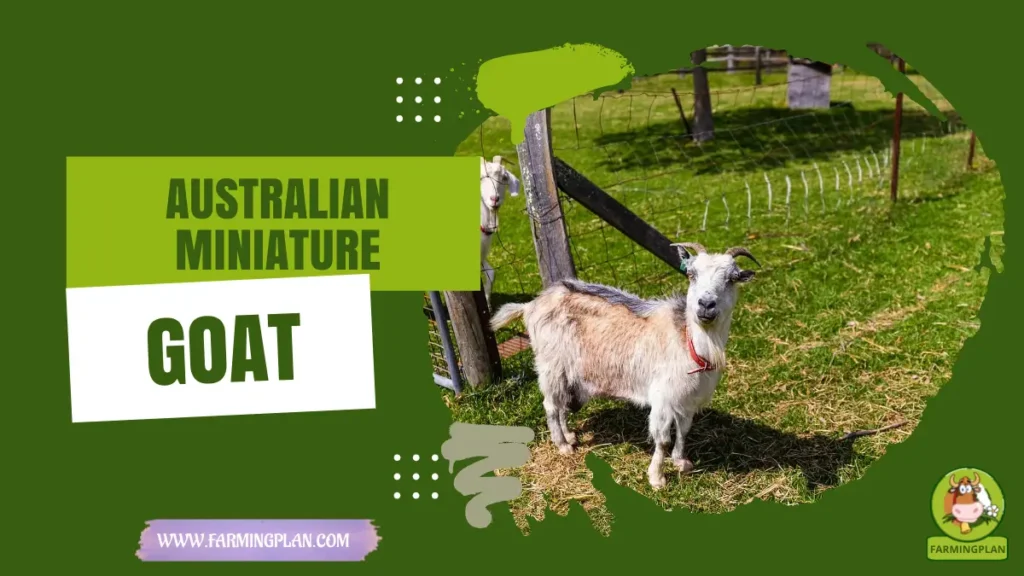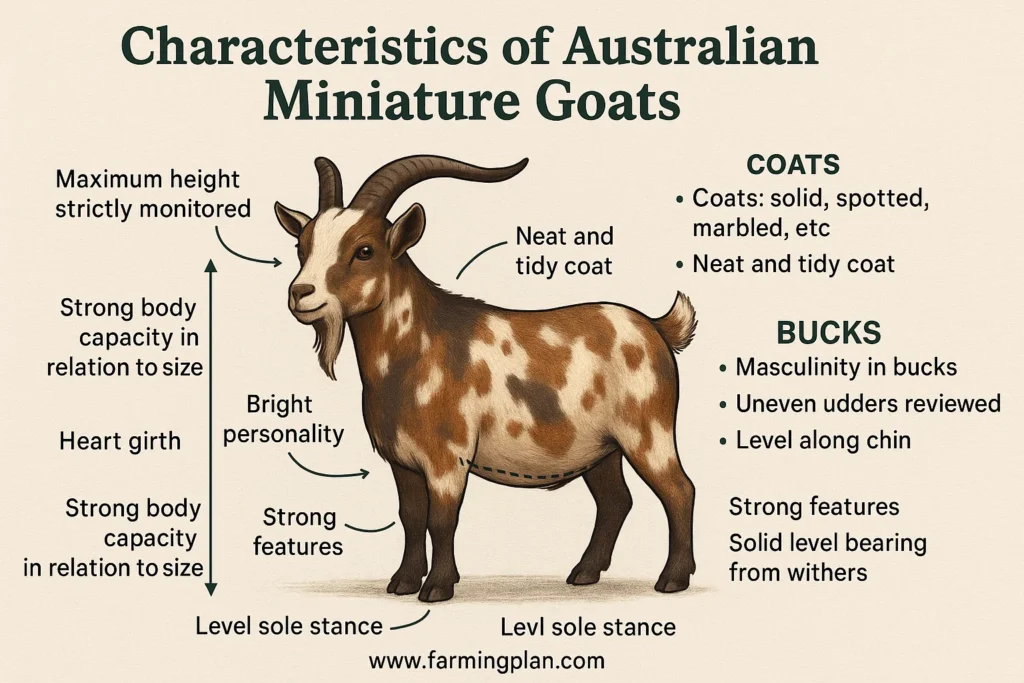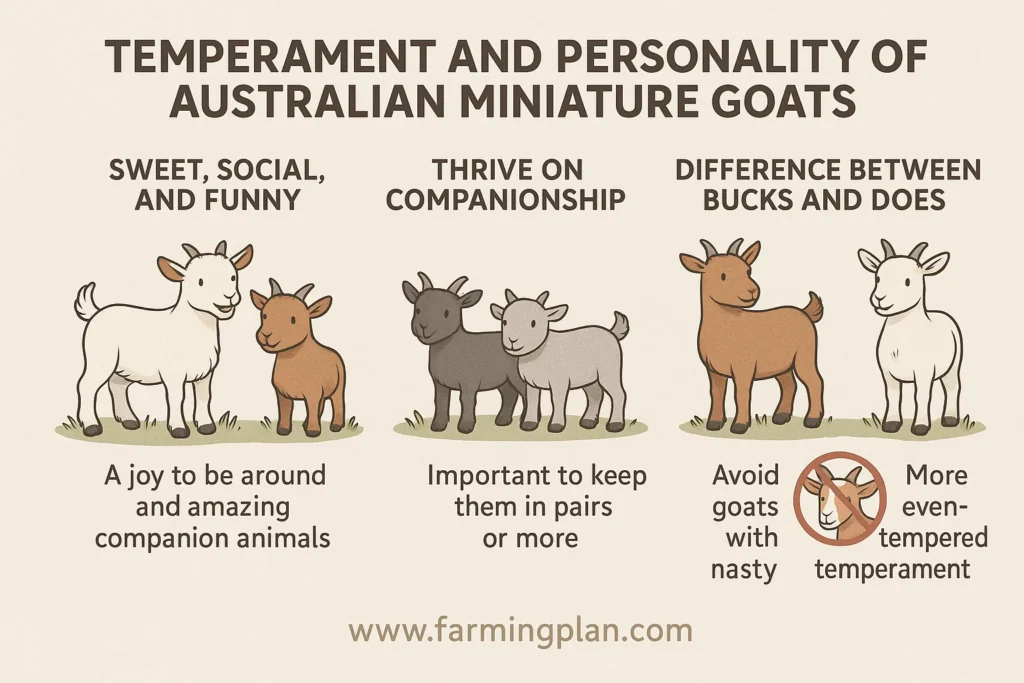If you’re anything like me, you love animals that are full of personality, easy to care for, and cute enough to melt your heart. That’s exactly why I fell in love with the Australian Miniature Goat. These little legends are friendly, hardy, and just the right size for hobby farms, backyards, or as a cuddly companion. Whether you’re a seasoned breeder or someone dreaming of adding a pint-sized pal to your life, this guide will walk you through everything you need to know—from their history and unique features to feeding, farming, and where to find your own mini goat. So grab a cuppa, sit back, and let’s talk goats—mini ones!

History and Origin of Australian Miniature Goats
Let’s rewind a bit. The Australian Miniature Goat didn’t just pop up overnight. It took years of careful planning, breeding, and a whole lot of goat know-how to create the adorable animals we know today. These goats were developed right here in Australia using a blend of small, sturdy breeds like the Pygmy Goat, Anglo Nubian, Angora, Bush Goat, and even the quirky Nuwby Goat.

Breeders aimed to combine the best traits—gentle temperament, compact size, and eye-catching looks. I’ve chatted with folks from Myall Forest Miniature Goat Stud, and let me tell you, these breeders take their goat heritage seriously. They’ve used generations of foundation stock and started the grading up process to refine genetics and create miniature stock with great body proportion and solid structure.
Every goat that’s part of the grading system is evaluated based on height, genetics grade, and pedigree contribution. This isn’t just backyard breeding—it’s a science and an art. Whether you’re into hobby farming or planning to breed, it’s fascinating to know that today’s adorable mini goat comes from a rich mix of global genetics and true-blue Aussie determination.
Read More: Boer Goat: Secrets to Starting a Successful
Characteristics of Australian Miniature Goats
So what does a proper Australian Miniature Goat actually look like? For starters, they’re small—really small. But don’t let that fool you. These goats are compact and well-built, with a strong body capacity in relation to their size. Their maximum height is strictly monitored, especially for registration purposes, and their heart girth plays a big role in judging their condition.

One of my favorite things about them is their coat. It can come in just about every colour combination you can imagine—solid, spotted, marbled—you name it. And each coat type must be neat, tidy, and healthy-looking to meet breed standards. Their bright personalities are only matched by their vibrant, colourful animal appearances.
Now let’s talk bucks. Male goats, or adult bucks, need to show masculinity in bucks—strong features, solid level bearing from withers, and a confident stance. A lack of masculinity is a no-go for breeding. And don’t even get me started on udders! While uneven udders are sometimes allowed, they’re carefully reviewed under grading rules to ensure health and productivity. Everything from level along the chine to level sole stance is considered.
Read More: Alpine Goat: Smart, Hardy & Milk-Rich Breed
Temperament and Personality of Australian Miniature Goats
I’ve raised a few different goat breeds over the years, but none have the charm of the Australian Miniature Goat. These guys are sweet, social, and downright funny. They’re a joy to be around, which is why they make amazing companion animals. Whether you’re a kid or a kid at heart, you’ll fall for their beautiful temperaments.

Remember, Australian Miniature Goats are herd animals. They thrive on companionship, so it’s important to keep them in pairs or more. This understanding of their social needs shows your responsibility and care as an owner.
Another thing to note is the difference between bucks and does. Bucks can be a bit bossy, especially during breeding season, but they’re still affectionate. Does are often more even-tempered and nurturing. Just steer clear of any animal with a nasty temperament—good breeders will always screen for that. These are lovely mini goat friends, not troublemakers.
Read More: Why Kiko Goats Are Perfect For Your Farm
Feeding and Nutrition for Miniature Goats
Feeding these mini champs is pretty straightforward. I stick to a basic diet of good quality hay, some chaff, and the occasional grain mix. Add fresh water and a mineral lick, and you’ve got yourself a healthy goat. It’s all about balance—don’t overdo the grain, especially with bucks.
Avoid human food, too—no bread, no meat, and absolutely no chocolate. Some plants can be toxic to goats, so make sure your grazing area is free of nasties like oleander or rhubarb leaves. If you’re unsure, always double-check before letting them munch freely.
And don’t forget enrichment! I love giving my goats fun DIY goat toys made from ropes, tires, and even old kid slides. Keeps them active and reduces boredom. Oh, and let me tell you—goat manure? Gold for the garden. These hardy animals give back in more ways than one.
Common Uses
Australian Miniature Goats are not just cute—they’re incredibly versatile. They can be raised as pet goats, entered in shows, or even used for small-scale milk production. Their dual-purpose nature opens up a world of possibilities, inspiring owners to explore the many roles these goats can play.
While they don’t produce as much milk as larger breeds, their creamy yield is enough for personal use. Some breeders even develop smaller-sized milking goats for backyard dairy setups. Others just love having them as adorable animals who follow you around the yard like a dog. Show circuits have also embraced the breed. Their flashy coats and confident presence make them real crowd-pleasers. And if you’re into popular goat breeds like the Pygmy, the Australian Miniature Goat is right up your alley—same charm, just Aussie-bred with a unique twist.
Unique Features That Make Them Stand Out
What makes Australian Miniature Goats truly stand out? Their unique features. From their unmatched range of colours to their hand-painted appearance, these goats are a sight to behold. It’s no wonder buyers often have preferred colours in mind when choosing their goats.
Then there’s their structure. Unlike random mixes, these goats have been bred for refinement of type—that means tidy lines, healthy bodies, and no oddball features. Breeders follow grading up processes and offer pedigree certificates to prove genetics and quality. I’ve also noticed that goats from lines like Petite Bleat Franklin Buck and Billy Goat Cyrus tend to have that extra “wow” factor. Whether it’s the ears, the markings, or just their charming vibe, these goats are the full package—beautiful goats with equally impeccable temperament.
Mini Goats, Massive Hearts—These Little Legends Bring Big Smiles To Every Paddock!
Health, Lifespan & Preventive Care
A healthy Australian Miniature Goat can live anywhere from 10 to 15 years—pretty great for a farm animal. But that kind of longevity only comes with good care. I always keep an eye out for things like limping, swollen joints, or signs of uneven udders, especially in does.
Routine vet visits, vaccinations, and hoof trimming are a must. I also use shelter with animal bedding to keep them warm and dry. Clean bedding equals clean goats, which equals fewer health issues. Goats are resilient, but don’t ignore small changes. A goat that’s usually chatty and suddenly quiet? That’s a red flag. Trust your gut. And if in doubt, call your vet. Prevention is always better—and cheaper—than treatment.
Step-by-Step Care Guide for Australian Miniature Goats
Whether you’re just starting out or expanding your miniature herd, proper care starts with the basics. Here’s how I personally care for my Aussie mini goats, step by step—straight from my paddock to yours!
Step 1: Set Up A Safe, Comfortable Shelter
Before you even bring your goats home, make sure they’ve got a safe place to live. These little guys might be mini, but they need proper housing just like any other livestock. Build or prep a sturdy shelter that protects them from wind, rain, and direct sun. I like to use a three-sided shed with a roof—simple, practical, and easy to clean. Make sure the flooring is dry and raised slightly above ground level to prevent water from pooling during wet weather.
Use comfortable bedding like straw, wood shavings, or hemp to keep things cozy and clean. I refresh my goats’ bedding every week or two, depending on how messy they get (spoiler alert: they love to make a mess). During winter, a thick layer of straw will keep them warm and happy. And don’t forget fencing! You’ll need secure fencing that’s at least 1–1.2 meters high. Goats are sneaky climbers and escape artists. I’ve had one cheeky buck squeeze through a dog flap—never again! Welded wire or mesh works best, and avoid anything with gaps big enough for tiny hooves to get caught.
Step 2: Create a Daily Feeding & Health Routine
Feeding time is one of the best ways to bond with your goats—and it’s also where good health starts. Your mini goats need access to fresh, clean water 24/7. I use heavy-duty buckets or troughs that can’t be tipped over (they’ll try). In summer, I check and refill water more frequently to avoid dehydration.
As for feed, stick to the basics:
- Good quality hay (like lucerne or meadow hay) should make up the bulk of their diet.
- Chaff and pellet blends can be offered once or twice a day in small portions—just enough to maintain healthy weight.
- Provide a mineral lick or loose minerals specifically made for goats to support their bones, coat, and immune system.
Treats like apple slices or banana peels are fine occasionally—but skip anything toxic (like avocado, chocolate, or garden rhubarb). Goats love variety, but safety first! Part of your daily routine should also include a quick once-over: Check for any limping, bloating, dull coat, or odd behavior. I always say, “If your goat’s acting weird, something’s probably up.”
Step 3: Make Sure They Have Goat Buddies (Never Keep One Alone!)
This is a BIG one: Goats are herd animals, and they absolutely need at least one buddy. Keeping a single goat is a recipe for stress, loneliness, and behavioral issues. If you’re just starting out, get a pair—ideally from the same breeder or litter so they’re already bonded. Same-sex pairs (two does or two wethers) are usually easiest to manage if you’re not planning to breed. If you do want to breed, keep your buck separate except during breeding season.
When introducing a new goat to an existing herd, do it slowly. Use a neutral area at first and allow them to sniff and suss each other out through a fence. I use a baby gate or livestock panel for a day or two before letting them mix fully. Be patient—sometimes it takes a few days to settle the pecking order. A good goat friend can prevent so many issues—loneliness, aggression, even health problems caused by stress. Two goats really are better than one (and twice the fun).
Step 4: Grooming, Hoof Care & Enrichment
Australian Miniature Goats don’t need constant pampering, but regular grooming keeps them healthy and happy. Plus, it’s a great way to bond. Brush them once or twice a week using a soft-bristle brush. This keeps their coat neat, removes dirt, and helps you check for any skin problems or parasites. During shedding season, you’ll thank yourself for keeping up with grooming—it can get hairy, literally.
Hoof trimming is essential. Every 6–8 weeks, check and clip their hooves to avoid overgrowth or hoof rot. If they’re walking on rocky surfaces often, natural wear may reduce trimming needs—but don’t rely on it. Get a good quality hoof trimmer, watch a few tutorials, and don’t be afraid to ask your vet or breeder for a demo if you’re unsure. Enrichment is the cherry on top. Goats are playful and curious, so give them stuff to climb on—wooden spools, ramps, logs, platforms. I once repurposed an old kids’ slide, and my goats acted like it was Disneyland. Chew toys, hanging ropes, and even puzzle feeders can keep them mentally stimulated and out of trouble.
Step 5: Understand Breeding, Registration & Pedigree Care
If you’re serious about raising registered Australian Miniature Goats, there’s more to it than just putting a buck and doe together.
First, make sure your animals are eligible for grading and registration. That means checking:
- Height limits (for both bucks and does),
- Lineage and foundation stock history,
- Conformation traits like upright stance, level spine, and healthy coats,
- And—this is important—temperament. Nasty goats should never be bred.
Breeding season can get busy. Keep bucks separate outside of mating periods. When it’s time, supervised mating is safest and ensures you track parentage correctly. Mark everything down—dates, pairings, any issues. Trust me, your future self will thank you when it’s time to register the kids.
Once kids are born, they can be registered through a breed society or goat club. You’ll need to provide photos, measurements, and information about the parents’ grade and genetics. This paperwork protects the breed and your investment. And remember, not all kids need to be bred—some make amazing pets or wethers (castrated males). Breeding responsibly is part of being a good goat steward.
Pro Tips and Best Practices from a Goat Breeder
Here’s my number one rule: Healthy goats are happy goats. Keep their environment clean, social life active, and diet balanced. Always check your goats daily and don’t skip grooming days. Want to save money? Use goat manure as compost—it’s amazing for veggies. Want a better bond? Spend time with them. Sit, talk, even sing. Trust me, goats love it.
Tip: “A Happy Mini Goat Always Has A Friend, Space To Jump, And A Good Brush-Down Every Week.”
Where to Buy Australian Miniature Goats
Ready to bring one (or two!) home? Look for Australian Miniature Goats for sale through verified breeders or local goat breeder networks. I highly recommend reaching out to Myall Forest Miniature Goat Stud or browsing stud goats listings online. You can also check local ag fairs, Facebook groups, or breed associations. Just make sure you’re buying from someone who provides registration certificates, info about genetics, and proper health checks. Don’t fall for cute pics alone—ask about foundation stock, pedigree, and percentage grading.
FAQ
How tall do Australian Miniature Goats get?
Most adult goats are under 60 cm tall, depending on grading and bloodlines.
Can you keep just one miniature goat?
No. Goats are herd animals and must be kept with at least one other goat for social health.
Are Australian Miniature Goats good for kids?
Absolutely! They’re gentle, friendly, and small enough to be safe around children.
How much space do they need?
They don’t need much—around 200–400 square meters per goat is enough with proper enrichment.
Can I milk my Australian Miniature Goat?
Yes, but the yield is small—great for personal use, not commercial dairy production.
Conclusion
The Australian Miniature Goat is truly a gem—small in size, big in personality. Whether you’re after a cute backyard companion or looking to start a small herd, these goats are an ideal match. With the right care, setup, and social structure, they’ll bring years of joy, laughter, and yes, the occasional mischief. So if you’re thinking of adding some hoofed happiness to your life, trust me—these mini goats are the way to go.
